The Meyer Family Award for Contemporary Art
The Main Line Art Center, in Haverford, has recently put up its 12th annual Betsy Meyer Memorial Exhibition, featuring the work of the 2016 Meyer Family Award for Contemporary Art recipients Sun Young Kang, Matthew Courtney, and Zahra Nazari. This is a relatively large exhibition in the Main Line Art Center’s beautiful galleries, and it is dominated by Nazari’s numerous paintings, including her large installation consisting of painted aluminum sheets, and by Courtney’s quirky sculptures, so I want to focus on Kang’s remarkable, but less conspicuous work.
“In Honor of My Grandmother’s Simple Life”
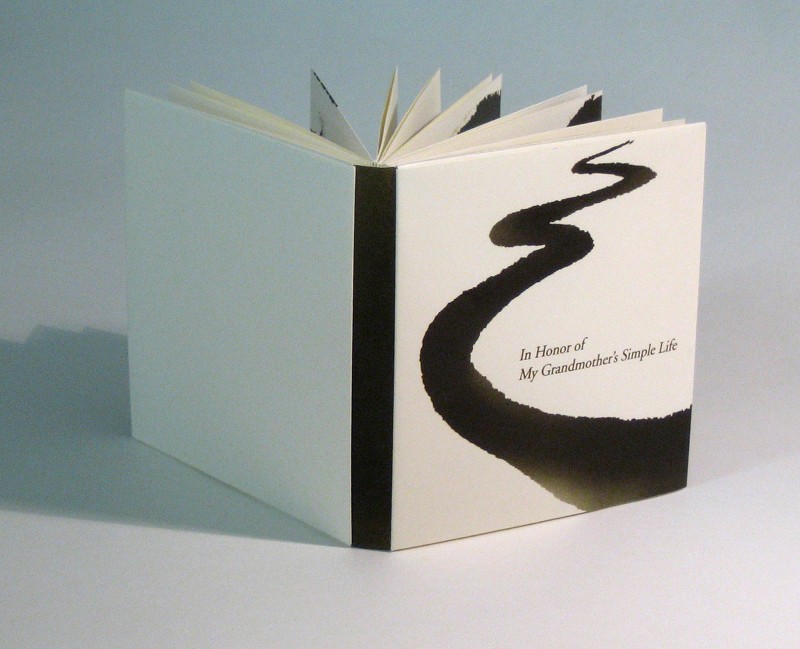
Kang has contributed three pieces to the exhibition: two diminutive hand-crafted books and a large installation of paper tubes and light, “In Between,” which fills a private room just off the floor of the main gallery. Both books fit into the palm of your hand. The larger of the two, “In Honor of My Grandmother’s Simple Life” (2006), measures 37/8” x 4 ½”.
The smaller one, a mere 1 3/4″ x 1 3/8″, is titled “Samsara” (2005 – 2007), from the Sanskrit, meaning “a wandering through,” which refers to the passage through many states of existence that is involved in the cycle of death and rebirth: “the ever-turning wheel of life”. It’s worth pointing out a breathtaking 2011 documentary of the same name, directed by Ron Fricke and produced by Mark Magidson—a guided meditation through dazzling worlds of sacred grounds, disaster zones, industrial complexes, and natural wonders in 25 countries on five continents. The comparison is worth making here because Kang covers much of the same spiritual territory in a delicate volume that folds up to the size of a matchbox.
“In Between”: The boundaries of presence and absence, life and death
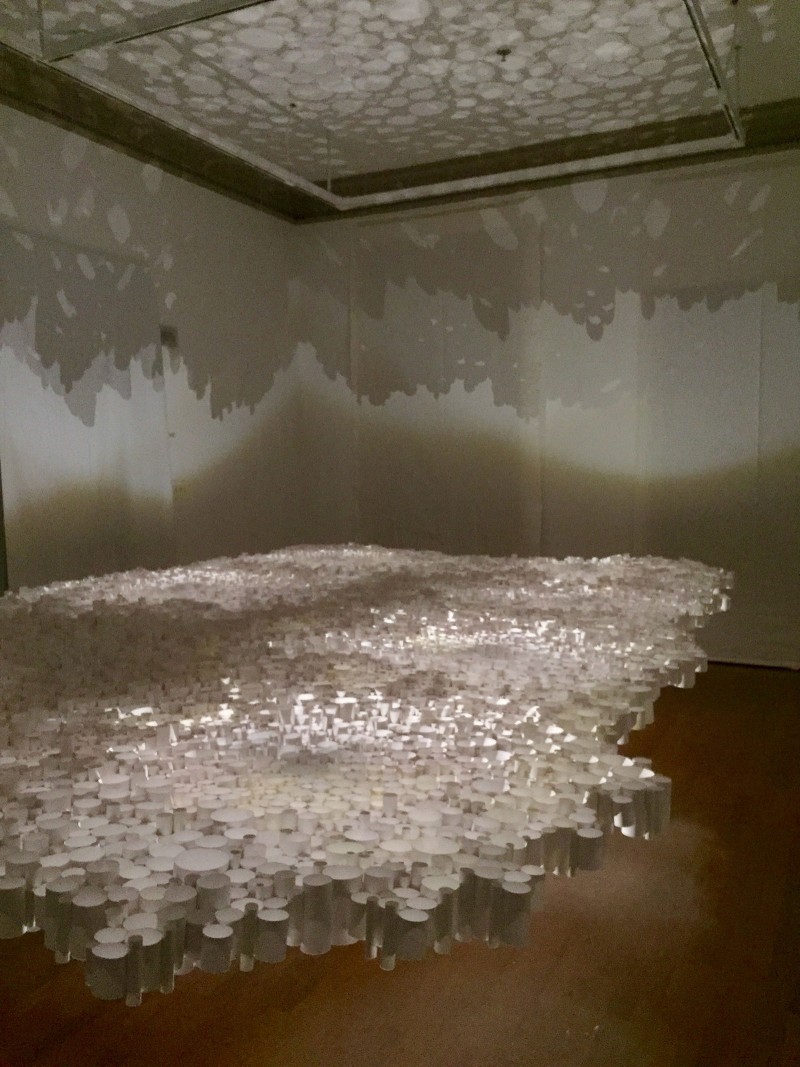
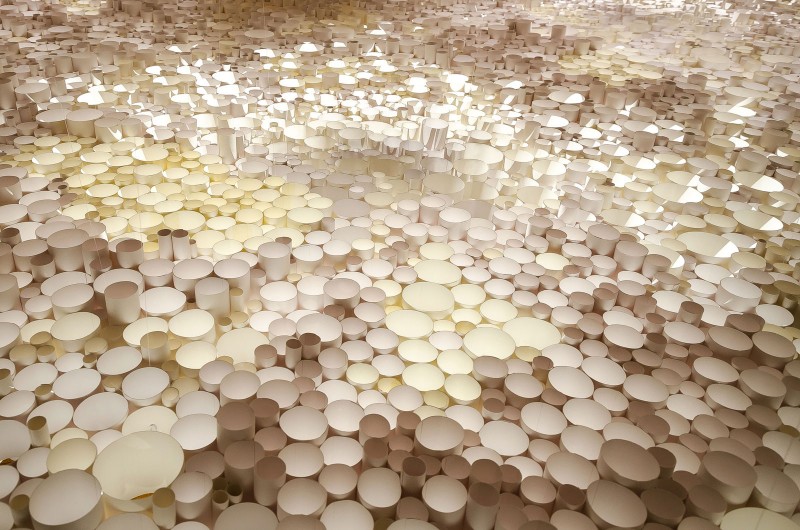
Kang’s “In Between” is a large field of small white paper tubes of varying sizes—they stand just a few inches tall—which seems to float in the room. The piece is illuminated from below, and sections of it light up as you walk around it. The patterns reflected on the walls and ceiling are as captivating as the form of the installation itself. There is a way in which it reminds me of Emil Lukas’s “Large Lens,” which I reviewed for Artblog when it was displayed at PAFA. Both works are portals that seductively and delightfully lead to perspectives on the world and to glimpses of elementary states of consciousness which might otherwise escape us. Kang, who sees her work as an attempt to secularize the Buddhist concept of “emptiness,” posits that her “tiny tubes… question the boundary of all antithetical ideas,” “presence and absence, life and death”.
Tchotschke Heaven
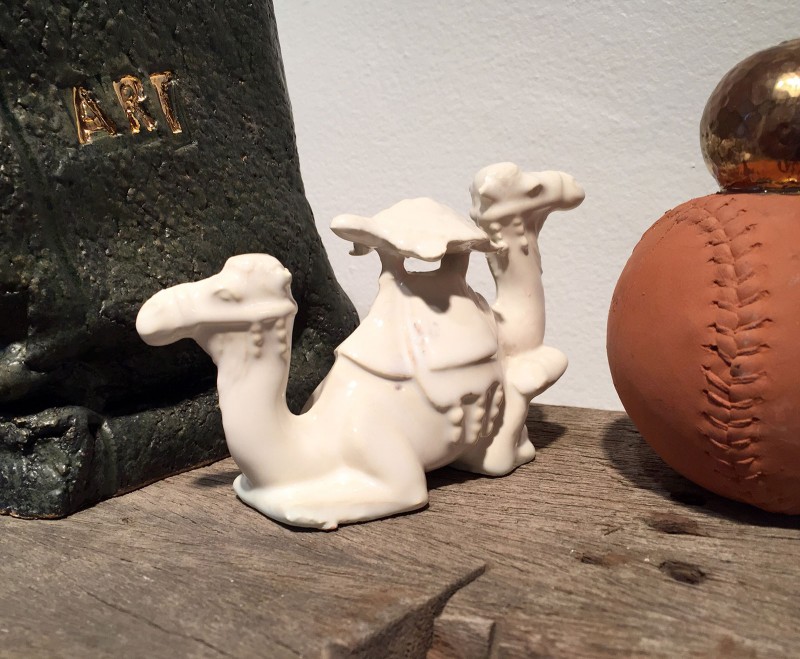
I have included here an image of what is perhaps a minor sample of Matthew Courtney’s work: “Push Me Pull You Tchotchke”. This small clay and glaze sculpture, which I understand was inspired by one of Hugh Lofting’s Doctor Dolittle books, depicts a white two-headed camel with a turtle hitching a ride on its back. I found it irresistible. For those of you unfamiliar with the Yiddish, Webster’s defines “tchotchke” as “a small object that is decorative rather than strictly functional; a trinket”. The Urban Dictionary’s blunt definition is: “A small piece of worthless crap, a decorative knickknack with little or no purpose”.
Needless to say, people often feel highly sentimental about their tchotchkes. I have a very close friend who ran a shop in Northampton, Massachusetts, called Tchotchke Heaven, which featured a wonderful mixture of odds and ends that defied classification, and which also served as a salon for human odds and ends, most of them intellectuals of one sort or another. It would have been no surprise to find one of Matthew Courtney’s creations at Tchotchke Heaven. “Push Me Pull You Tchotchke” is clearly the most understated of Courtney’s ceramic sculptures included in this exhibition. I found many of the other pieces—including rockets with birds sitting on their noses and various kooky adaptions of footballs and basketballs, for example—rather heavy-handed.
Nazari’s “Deconstructed Spaces”

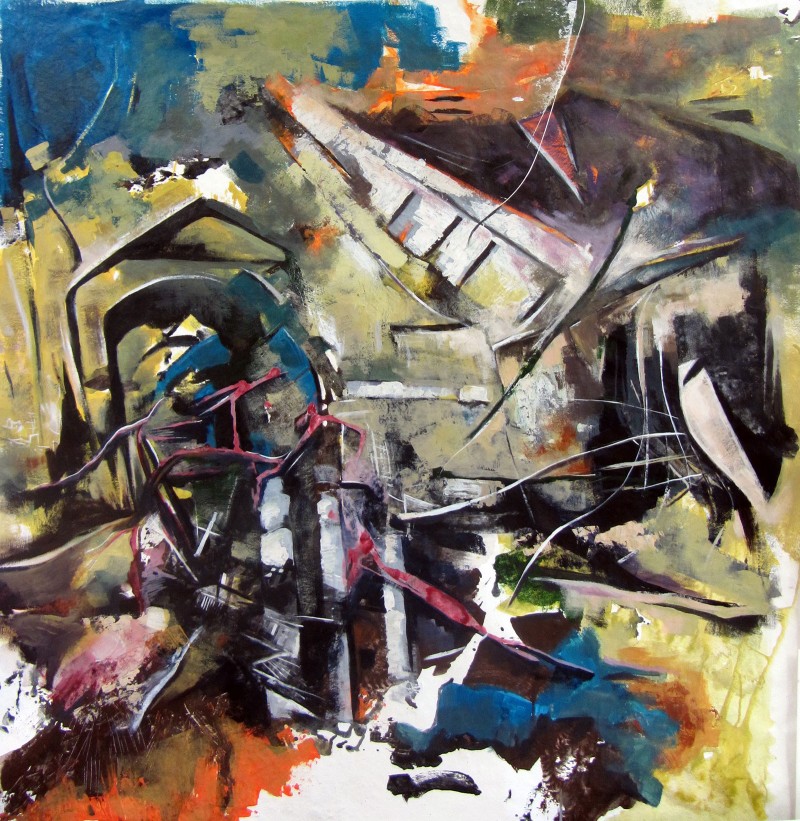
As I noted above, Zahra Nazari’s work dominates the exhibit, particularly her large installation, “Deconstructing Spaces”. I’ve also included the image of one of her many acrylic paintings, “Site #28”. Nazari’s work, abstract urbanscapes and landscapes, has apparently been inspired by her interest in architecture, particularly by landscapes surrounding architecture, and by archaeology, the ruins of ancient sites. She attempts to “merge ancient and modern architectural forms with floating, collapsing and shifting environments,” creating “fictitious structures situated within imaginary landscapes”. Nazari has acknowledged that perspectives are distorted in her work, and that they convey a sense of ambiguity that may leave the viewer feeling baffled. I certainly experienced that, and indeed I wondered whether the degree of abstraction of the work overcomes the imagery that the artist is seeking to explore. Nazari is clearly a gifted painter; it would be nice to see more variety in her work.
I assume, but am not sure whether the three artists who received this year’s Meyer Family Award for Contemporary Art were selected with a view to showing their work together. Of course, it’s never an easy task to integrate the work of three artists into a coherent exhibition, and particularly where, as here, the work is so diverse. Veteran curator Amie Potsic, who is also the executive director of the Main Line Art Center, has accomplished that task elegantly in Transitions. Indeed, she has engineered the transition from Nazari to Courtney to Kang with a seamlessness that I would not have foreseen. Perhaps my only misgiving is that, although the gallery is spacious, I think it is still slightly too small for Nazari’s dramatic “Deconstructing Spaces”.
Sun Young Kang, originally from South Korea, lives in Bryn Mawr and received her MFA in Book Arts/Printmaking from the University of the Arts in 2007. She was a fellow of the Center for the Emerging Visual Arts in Philadelphia from 2013 to 2015 and a participant in the 2013 Sofia International Paper Art Biennale. Kang has exhibited her work widely, both nationally and internationally, and her work is included in various public and private collections.
Matthew Courtney, a Philadelphian, received an MFA from Kent State University. He teaches at the University of Pennsylvania, the University of the Arts, and Tyler School of Art. He received an Ohio Arts Council Artist Fellowship and a Jerome Foundation Fellowship, and his work has been on exhibition in various settings in the United States, and in China.
Zahra Nazari is originally from Iran. She received an MFA in Painting/Drawing at the State University of New York, New Paltz. She is currently a recipient of the AIM Fellowship from the Bronx Museum and received a Visiting Artist Fellowship from the Cooper Union School of Art and a Ruth Katzman Scholarship from the Art League Residency at Vyt, Sparkill, New York. She lives in New York and has exhibited worldwide.
Transitions will be on display in the gallery at the Main Line Art Center through April 17, 2016.









